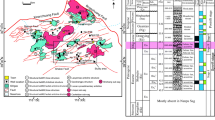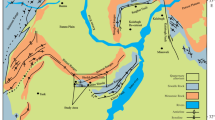Abstract
The Upper Cretaceous sedimentary facies in areas around Inyi and environs, southeastern Nigeria comprises Ajali and Nsukka formations. A total of 19 outcrops were mapped and logged. Interpretation was based on field facies analysis and laboratory tests which include granulometric and X-ray diffraction (XRD) analyses of the rock samples. The objective of the study was to reconstruct the environment of deposition as well as understand the textural attributes of the sand size sediments for reservoir quality assessment. Eleven lithofacies: conglomeritic sandstone facies (Gc), cross-bedded sandstone facies (Scb), pebbly sandstone facies (Sp), bioturbated sandstone facies (Sb), heterolithic facies (Sht), claystone facies (Cl), coal facies (Co), bioturbated shale facies (Shb), laminated siltstone facies (Stl), muddy sandstone facies (Sm), and black carbonaceous shale facies (Shcb), were identified with four sub-facies occurring within low- to high-energy environment. These lithofacies were grouped into four facies association (FA1, FA2, FA3, and FA4). FA1 is dominantly conglomerates and pebbly sandstone deposited as channel/alluvial fan deposits. FA2 are deposits in a swamp or lagoon setting consisting of coal and black carbonaceous shale. FA3 is characterized by bioturbated sandstone, muddy sandstone, and heteroliths deposited in a lower shoreface setting. The cross-bedded sandstones and the heterolithic facies belong to the FA4 deposited in an upper shoreface setting. Sieve analysis results show sediments that are medium to coarse grained in sizes, poorly to moderately sorted, dominantly very negatively skewed to symmetrical and mainly mesokurtic. These granulometric attributes are typical of shallow marine deposits influenced by fluvial processes under low- to high-energy conditions. Result of XRD analysis show the presence of clay and non-clay minerals in the sediments, with quartz as the most dominant. Diagenetic processes which include compaction, cementation, precipitation, and dissolution influenced the reservoir quality of the sands. Compaction significantly reduced the primary porosity, and the sand-size grains (quartz) created a self-supporting framework while the clay minerals, mainly kaolinite and dickite, occluded the pores spaces. Dissolution removed some detrital grains leaving obvious indications of few interconnecting and independent pores and moderately to poorly sorted sands. These clay minerals bridge the pore throat connectivity and cause reduction in pore radii, and consequently reducing the reservoir potentials of the sands. However, the sediments could serve as potential hydrocarbon reservoirs especially for gas. The coal seams and the black carbonaceous shale facies can serve as the source or seal rocks whereas the sandstone, siltstone, and heteroliths are possible reservoir rocks of the petroleum system in the study area.

















Similar content being viewed by others
Data availability
Data used in this research can be obtained from the corresponding author on reasonable request.
References
Abraham E, Itumoh O, Chukwu C, Rock O (2019) Geothermal energy reconnaissance of southeastern Nigeria from analysis of aeromagnetic and gravity data. Pure Appl Geophys 176:1615–1638
Akaegbobi IM, Boboye OA (1999) Textural, structural features and microfosill assemblage relationship as a delineating criterion for the stratigraphic boundary between Mamu Formation and Nkporo Shale within the Anambra basin, Nigeria. NAPE Bull 14:193–207
Anyiam OA, Onuoha KM (2014) A study of hydrocarbon generation potential and expulsion of the Nkporo Shales in Anambra Basin, Nigeria. Arab J Geosci 7:3779–3790
Aoki S, Kohyama N (1991) The vertical change in clay mineral composition and chemical characteristics of smectite in sediment cores from the southern part of the central Pacific Basin. Mar Geol 98:41–49
Baiyegunhi C, Liu K, Gwavava O (2017) Grain size statistics and depositional pattern of the Ecca Group sandstones, Karoo Supergroup in the Eastern Cape Province, South Africa. Open Geosciences 9:554–556
Benkhelil J (1989) The origin and evolution of the Cretaceous Benue Trough (Nigeria). J Afr Earth Sc 8:251–282
Boggs S (2009) Petrology of sedimentary rocks. Cambridge University Press, Cambridge, pp 21–29
Burke KC, Dessauvagie TF, Whiteman AJ (1972) Geological history of the Benue valley and adjacent areas. In: Dessauvagie TF, Whiteman AJ (eds) Proceedings on the conference on African Geology. Ibadan University Press, Ibadan, pp 187–205
Chiaghanam OI, Nwozor KK, Chiadikobi KC, Omoboriowo AO, Saoronnadi-ononiwu CG, Onuba LN, Ofoma AE (2013) Lithofacies, paleoecology and paleoenvironmental study of Early Campanian to Mid-Maastrichtian deposits of Udi and Environs in the Anambra Basin, southeastern Nigeria. Int J Sci Technol 2:453–470
Clifton CF, Day KT, Luce CH, Grant GE, Safeeq M, Halofsky JE, Staab BP (2006) Effects of climate change on hydrology and water resources in the Blue Mountains, Oregon, USA. Clim Serv 10:9–19
Coalson EB, Inden RF (1990) Geology and oil production of the Ervay. Mt Geol 27:77–98
Collinson J, Mountney N, Thompson D (2006) Sedimentary structures. Terra Publishing, Hertfordshire, pp 129–292
Dam G (1990) Palaeoenvironmental significance of trace fossils from the shallow marine Lower Jurassic Neill Klinter Formation, East Greenland. Palaeogeogr Palaeoclimatol Palaeoecol 79:221–248
Dim CIP, Okwara IC, Mode AW, Onuoha KM (2016) Lithofacies and environments of deposition within the middle–Upper Cretaceous successions of southeastern Nigeria. Arab J Geosci 9:447–459
Ekweozor CM (2006) Searching for petroleum in the Anambra Basin, Nigeria. In: Okogbue CO (ed) Hydrocarbon potentials of the Anambra Basin. Great AP Express Publication Limited, Nsukka, pp 47–82
Folk RL, Ward WC (1957) Brazon River Bar: a study of the significance of gram size parameters. J Sediment Petrol 27:3–26
Friedman GM (1961) Distinction between dune, beach, and river sands from their textural characteristics. J Sediment Res 31:514–529
Ghazi S, Mountney NP (2009) Facies and architectural element analysis of a meandering fluvial succession: the Permian Warchha Sandstone, Salt Range, Pakistan. Sed Geol 221:99–126
Hampson GJ (2010) Sediment dispersal and quantitative stratigraphy architecture across an ancient shelf. Sedimentology 57:96–141
Hjellbakk A (1997) Facies and fluvial architecture of a high-energy braided river: the Upper Proterozoic Seglodden Member, Varanger Peninsula, northern Norway. Sed Geol 114:131–161
Hoque M, Ezepue MC (1977) Petrology and paleogeography of the Ajali Sandstone. J Min Geol 14:16–22
Howard JD, Frey RW (1984) Characteristic trace fossils in nearshore to offshore sequences, Upper Cretaceous of east-central Utah. Can J Earth Sci 21:200–219
Keller WD (1945) Size distribution of sand in some dunes, beaches, and sandstones. Am Assoc Pet Geol Bull 29:215–221
Kogbe CA (1989) The Cretaceous and Paleogene sediments of Southern Nigeria. In: Kogbe CA (ed) Geology of Nigeria, Elizabethan Pubications, Lagos, pp. 273–286
Krumbein WC, Monk GD (1943) Permeability as a function of size parameters of unconsolidated sand. Trans AIME 15:153–163
Kvale EP (2006) The origin of neap-spring tidal cycles. Mar Geol 235:5–18
Kwetche P, Ntamak-Nida MJ, Nitcheu ALD, Etame J, Owono FM, Mbesse CO, Bilong P (2018) Facies analysis and sequence stratigraphy of Missole outcrops: N’Kapa Formation of the southeastern edge of Doula Sub-Basin (Cameroon). Earth Sci Res 7:35–54
Mc Cabe AM, Dardis GF, Hanvey PM (1987) Sedimentology of a Late Pleistocene sub-marine-moraine complex, County Down, Northern Ireland. J Sediment Res 54:716–730
Mcllroy D (2004) Ichnofabrics and sedimentary facies of a tide-dominated delta: Jurassic Ile Formation of Kristin Field, Haltenbanken, offshore Mid-Norway. Geological Society, London, Special Publications 228:237–272
Miall AD (2000) Principles of sedimentary basin analysis. Springer-Verlag, Berlin, pp 141–153
Miola RJ, Weiser D (1977) Textural parameters: an evaluation. J Sediment Petrol 38:45–53
Mode A, Ekwenye O, Oha I, Onah F (2018) Facies analysis and ichnology of a prograding river-dominated and wave-influenced deltaic deposit: the Nkporo Formation in the Itigidi-Ediba region of the Afikpo Sub-basin, south-eastern Nigeria. J Afr Earth Sc 147:152–168
Mode AW, Odumodu CFR (2014) Lithofacies and ichnology of the late Maastrichtian-Danian Nsukka Formation in the Okigwe area, Anambra Basin, southeastern Nigeria. Arab J Geosci 8:7455–7466
Nichols GJ, Hirst JP (1998) Alluvial fans and fluvial distributary systems, Oligo-Miocene, Northern Spain; contrasting processes and products. J Sediment Res 68:879–889
Nichols A, Tamura Y, Sato T, Fujiwara O, Kodaira S (2016) Advents of continents: a new hypothesis. Sci Rep 6:63–101
North FK (1985) Petroleum geology. University Press, Cambridge, pp 187–202
Nwajide CS (2005) Anambra Basin of Nigeria: synoptic basin analysis as a basis for evaluating its hydrocarbon productivity. In: Okogbue CO (ed) Hydrocarbon potentials of the Anambra Basin: geology, geochemistry and geohistory perspective. University of Nigeria, Nsukka, Petroleum Technology Development Fund, pp 1–46
Nwajide CS, Reijers TJ (1996) Sequence architecture in outcrops. Examples from the Anambra Basin, Nigeria. NAPE Bull 11:23–32
Nwajide CS (2013) Geology of Nigeria’s sedimentary basins. CSS Bookshops Limited, Lagos, p 71
Obaje NG, Wehner H, Scheeder G, Abubakar MB, Jauro A (2004) Hydrocarbon prospectivity of Nigeria’s inland basins: from the viewpoint of organic geochemistry and organic petrology. American Association of Petroleum Geologists’ Bulletin 88:325–353
Obi GC (2000) Depositional model for the Campanian-Maastrichtian Anambra Basin, Southern Nigeria. Unpublished Ph.D Thesis, University of Nigeria, Nsukka
Odumodu CFR (2014) Ichnology and lithofacies analysis of the Campano-Maastrichtian Mamu Formation in the northern parts of the Anambra Basin, Nigeria. Int J Geol Earth Environ Sci 4:130–137
Onac BP, White WB (2003) First reported sedimentary occurrence of berlinite (AlPO4) in phosphate bearing sediments from Ciodovina cave, Romania. Am Miner 88:1395–1397
Ozioko OH, Obialo OS, Ezugwu CK (2020) Micropaleontological analysis of rocks of Mbakwah and environs, Gboko, southeast Nigeria. GJSFR 20:53–66
Reading HG, Levell BK (1996) Sedimentary environments: processes, facies and stratigraphy. Blackwell Science, Cambridge, pp 36–49
Reineck HE, Singh IB (1980) Depositional sedimentary environments: with reference to Terrigenous Clastics. Springer-Verlag, Berlin, pp 162–182
Reinson GE (1992) Transgressive barrier island estuarine systems. In: Walker RG, James NP (eds), Facies models response to sea level change, Geotext, Canada, pp 179–194
Saeed AR, Abdi S (2016) Grain size analysis and depositional environment foe beach sediments along Abu Dhabi coast, United Arab Emirates. Int J Sci Technol Res 5:106–115
Sahu KB (1964) Depositional mechanisms for size analysis of clastic sediments. J Sediment Petrol 34:73–83
Shanley KW, McCabe PJ, Hettinger RD (1992) Tidal influence in Cretaceous fluvial strata from Utah, USA: a key to sequence stratigraphic interpretation. Sedimentology 39:905–930
Uba CE, Heubeck C, Hulka C (2005) Facies analysis and basin architecture of the Neogene Subandeansynorogenic wedge, southern Bolivia. Sed Geol 180:91–123
Wright JB, Hastings DA, Jones WB, Williams HR (1985) Geology and Mineral Resources of West Africa. George, Allen and Union, London
Acknowledgements
This work is part of Miss Odu’s M.Sc. research at the University of Nigeria, Nsukka. She is grateful to the postgraduate students of the Department of Geology, University of Nigeria, Nsukka who provided technical input that improved the quality of this work.
Author information
Authors and Affiliations
Contributions
Okwudiri Aloysius Anyiam conceptualized and supervised the study. Nkem Judith Odu, Chidubem Okwudiri Emedo, Kachikwulu Kingsley Okeke, and Ngozi Augustina Ulasi participated in field work, laboratory studies, and data analysis. Chidubem Okwudiri Emedo drafted the manuscript.
Corresponding author
Ethics declarations
Conflict of interest
The authors declare no conflict of interest.
Additional information
Responsible Editor: Attila Ciner
Rights and permissions
About this article
Cite this article
Odu, N.J., Anyiam, O.A., Emedo, C.O. et al. Sedimentology, diagenesis, and reservoir quality assessment of the Upper Cretaceous sedimentary succession (Anambra Basin) in Inyi and environs, southeastern Nigeria. Arab J Geosci 14, 2627 (2021). https://doi.org/10.1007/s12517-021-09003-0
Received:
Accepted:
Published:
DOI: https://doi.org/10.1007/s12517-021-09003-0




